First two days at Oliver Lee
Friday
On Friday morning, I awoke with a grateful heart and an eagerness to explore and enjoy Oliver Lee State Park. Cat had a restless night – she was on and off my bed plenty of times; and one time she landed with a thud. I think she had leaped from the back of the dining bench to the bed. When I sat down with my coffee, the morning bird chorus started up.
I had breakfast and then walked around to see how many different birds I could spot, and ended up at the Visitor’s Center for information. As I walked past an RV in site #27, I noticed they were unhooking. The site looked pretty level and it had a cabana/windbreak. Then I noticed the sign that said: Campground Host. Bummer.
At the Visitor’s Center, on a whim, I asked about the Campground Host site. They were not expecting anyone, and yes I could move into it. Yippee!! I hustled back, unhooked my electricity, (hadn’t hooked up anything else) moved Jeremiah and easily leveled and extended my slide.
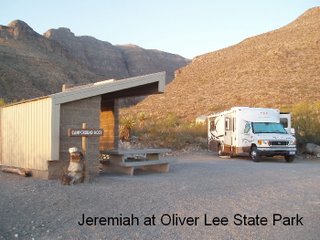
On Friday afternoon, I explored Dog Canyon’s Riparian Nature Trail, starting at the visitor’s center. As advertised, it is a short, scenic loop hike into the canyon alongside a spring-fed creek. Benches and tables are scattered along the trail, and interpretive signs put names to the plants: cactus and ocotillo in the beginning along with cottonwood and ash trees; farther up were creek-side plants such as desert willow, ferns, columbines, and even a type of orchid. The last portion of the trail ends with a boardwalk – and a healthy stand of poison ivy well off the trail – and steps to a viewing place.
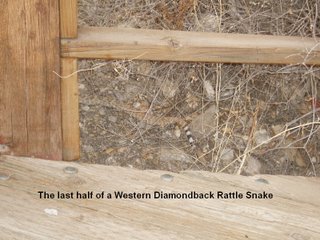

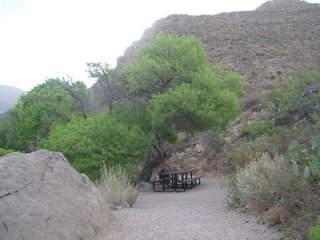 Yes, there was a Western Diamondback Rattlesnake moving along under the stairs – easy to see, but thankfully impossible for him to strike at me. The rear-end photo was the best I could get.
Yes, there was a Western Diamondback Rattlesnake moving along under the stairs – easy to see, but thankfully impossible for him to strike at me. The rear-end photo was the best I could get.When I headed back, I took the lower end of the loop that ended at the ruins of Frenchy’s Cabin. Francois-Jean “Frenchy” Rochas was a French immigrant who lived alone at Dog Canyon from 1886 until 1894. Reportedly he came here for his health. In his short eight-year residency, he tapped water from Dog Canyon, grew a successful orchard and vineyard in the desert and tended his cattle herds. By himself, he built a long rock, mortar-less wall up the steep slopes of the canyon to contain his cattle. He died from a bullet wound to his chest – a still-unsolved mystery.
Saturday
On Saturday I joined the ranger-led plant hike. I had met Ranger Charles Wood last year at Santa Rosa Lake State Park. He is very knowledgeable about plants and surprised me with some of his statements. Do you remember that in a previous trip blog I had declared “dead” an ocotillo that had a few blossoms at the end of otherwise dead looking stalks? Well, I stand corrected. I learned that when enough water is available, an ocotillo will produce both leaves and flowers. When water is scarce, the ocotillo only makes flowers in order to reproduce. And I always thought at the ocotillo was just another cacti – but it is not. It is considered a shrub.
Why choose to study and learn about plants when birds seem more interesting? While on the plant walk two birds landed on a nearby mesquite. Ranger Charles said, I think it is a warbler but I don’t have my binoculars to be sure. A man who had binoculars looked but then said the birds won’t sit still long enough to identify. Charles responded, “that’s why I study plants – they don’t fly off while I’m figuring out what they are.”
There were about 20 people on the hike.
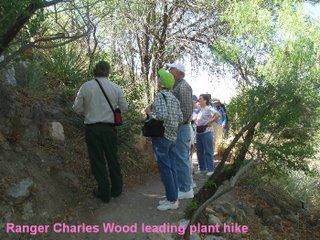
And speaking of birds, my bird feeders and a makeshift watering dish have attracted a good number of birds – finches, sparrows, doves, towhees, grosbeaks, and wrens. One feeder is suction-cupped to a window and Cat spends a lot of time watching the birds, too.
After lunch on Saturday, I gathered with a small group for a tour of the Oliver Lee ranch house. It is about a mile away, and Ranger Charles let me ride with him. He started the tour by talking about Oliver Lee (1865 – 1941), one of the most colorful and influential men in New Mexico history.
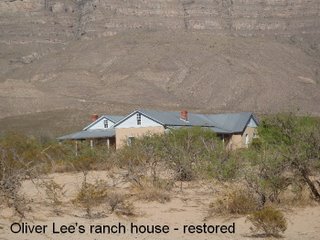
These past two days I’ve been reading Barbara Kingsolver’s novel, Prodigal Summer, set in the mountains and farms of southern Appalachia. The author’s knowledge and insight of the flora and fauna of that area was fascinating. The choices the characters in the book “made” reminded me of some pithy words attributed to Eleanor Roosevelt:
One's philosophy is not best expressed in words; it is expressed in the choices one makes. In the long run, we shape our lives and we shape ourselves. The process never ends until we die. And, the choices we make are ultimately our own responsibility.

<< Home